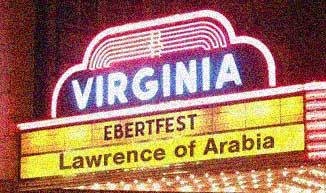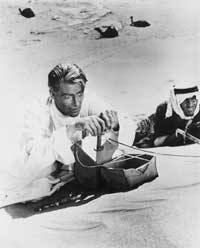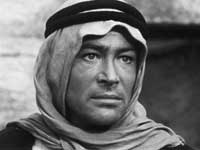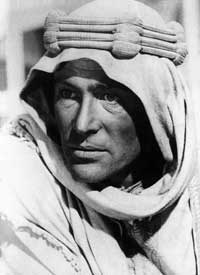|
|
 |
|
|
|
What a
bold, mad act of genius it was, to make ''Lawrence of Arabia,'' or even
think that it could be made. In the words years later of one of its
stars, Omar Sharif: ''If you are the man with the money and somebody
comes to you and says he wants to make a film that's four hours long,
with no stars, and no women, and no love story, and not much action
either, and he wants to spend a huge amount of money to go film it in
the desert--what would you say?'' |
|
 |
There is a moment in the film when
the hero, the British eccentric soldier and author T.E. Lawrence, has
survived a suicidal trek across the desert and is within reach of
shelter and water--and he turns around and goes back, to find a friend
who has fallen behind. This sequence builds up to the shot in which the
shimmering heat of the desert reluctantly yields the speck that becomes
a man--a shot that is held for a long time before we can even begin to
see the tiny figure. On television, this shot doesn't work at
all--nothing can be seen. In a movie theater, looking at the stark
clarity of a 70mm print, we lean forward and strain to bring a detail
out of the waves of heat, and for a moment we experience some of the
actual vastness of the desert, and its unforgiving harshness. |
 |
|
|
T.E. Lawrence must be the strangest hero ever to
stand at the center of an epic. To play him, Lean cast one of the
strangest of actors, Peter O'Toole, a lanky, almost clumsy man with a
beautiful sculptured face and a speaking manner that hesitates between
amusement and insolence. O'Toole's assignment was a delicate one.
Although it was widely believed that Lawrence was a homosexual, a
multimillion-dollar epic filmed in 1962 could not be frank about that.
And yet Lean and his writer, Robert Bolt, didn't simply cave in and
rewrite Lawrence into a routine action hero. Everything is here for
those willing to look for it. |
|
|
|
What Lean, Bolt and O'Toole create is a sexually
and socially unconventional man who is simply presented as what he is,
without labels or comment. Could such a man rally the splintered
desert tribes and win a war against the Turks? Lawrence did. But he
did it partially with mirrors, the movie suggests; one of the key
characters is an American journalist (Arthur Kennedy), obviously
inspired by Lowell Thomas, who single-handedly laundered and retailed
the Lawrence myth to the English-language press. The journalist admits
he is looking for a hero to write about. Lawrence is happy to play the
role. And only role-playing would have done the job; an ordinary
military hero would have been too small for this canvas. |
|
|
|
I've noticed that when people
remember ''Lawrence of Arabia,'' they don't talk about the details of
the plot. They get a certain look in their eye, as if they are
remembering the whole experience, and have never quite been able to put
it into words. Although it seems to be a traditional narrative
film--like ''Bridge on the River Kwai,'' which Lean made just before it,
or ''Doctor Zhivago,'' which he made just after--it actually has more in
common with such essentially visual epics as Kubrick's ''2001'' or
Eisenstein's ''Alexander Nevsky.'' It is spectacle and experience, and
its ideas are about things you can see or feel, not things you can say.
Much of its appeal is based on the fact that it does not contain a
complex story with a lot of dialogue; we remember the quiet, empty
passages, the sun rising across the desert, the intricate lines traced
by the wind in the sand. |
|
|
To see it in a movie theater is to
appreciate the subtlety of F.A. (Freddie) Young's desert
cinematography--achieved despite blinding heat, and the blowing sand,
which worked its way into every camera. ''Lawrence of Arabia'' was one
of the last films to actually be photographed in 70mm (as opposed to
being blown up to 70 from a 35mm negative). There was a hunger within
filmmakers like Lean (and Kubrick, Coppola, Tarkovsky, Kurosawa and
Stone) to break through the boundaries, to dare a big idea and have the
effrontery to impose it on timid studio executives. The word ''epic'' in
recent years has become synonymous with ''big budget B picture.'' What
you realize watching ''Lawrence of Arabia'' is that the word ''epic''
refers not to the cost or the elaborate production, but to the size of
the ideas and vision. Werner Herzog's ''Aguirre, the Wrath of God''
didn't cost as much as the catering in ''Pearl Harbor,'' but it is an
epic, and ''Pearl Harbor'' is not. |


